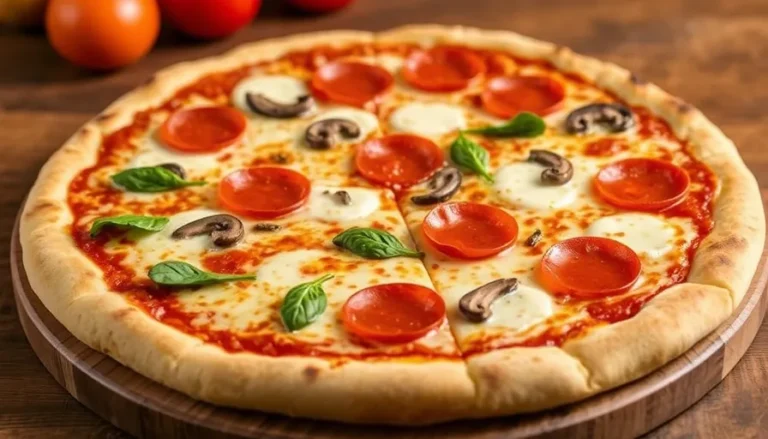In the world of Italian cuisine, radiatore pasta is a true gem. Its unique ridges and compact shape make it stand out. This recipe will show you how to make a delicious radiatore pasta dish. It will take you on a journey to the heart of Italy.
Key Takeaways
- Radiatore pasta is a distinctive Italian pasta shape with a unique, radiator-like appearance and texture.
- Radiatore pasta is prized for its ability to capture and enhance the flavors of a wide range of sauces.
- This recipe will provide you with the steps to create an authentic radiatore pasta dish that celebrates the traditional flavors of Italian cuisine.
- Radiatore pasta is a versatile ingredient that can be used in a variety of pasta dishes, from classic tomato sauce to creamy pesto.
- Cooking radiatore pasta al dente is crucial to achieve the perfect texture and flavor profile.
Exploring the World of Radiatore Pasta
Radiatore pasta is a unique pasta shape that stands out from others like spaghetti or penne. Its ribbed texture and compact look come from an old Italian pasta-making tradition. The name “radiatore” comes from its resemblance to a car radiator, with its ridges and grooves.
What Makes Radiatore Pasta Unique?
The pasta’s unique features add to its visual appeal. They also help it hold onto flavors in a special way. This makes eating radiatore pasta a truly unique experience.
The History and Origins of Radiatore Pasta
Radiatore-pasta comes from Italy’s rich culinary history. It’s been a favorite for centuries, often in classic dishes. This traditional pasta shows Italy’s commitment to keeping its traditional pasta shapes and recipes alive.
The shape and texture of radiatore-pasta make it a standout in the pasta world. It offers a memorable dining experience for pasta lovers. Whether you’re diving into Italian cuisine or just want to try something new, radiatore-pasta will impress your taste buds.
Mastering the Radiatore Pasta Recipe
Making the perfect radiatore-pasta starts with the right ingredients and technique. You’ll need high-quality semolina flour for a firm, al dente texture and a nutty flavor. The dough is kneaded well and then shaped through a special die, creating the pasta’s unique ridges.
Getting the pasta just right is key. It’s boiled in salted water until it’s al dente. With practice, you’ll master making radiatore-pasta and enjoy its special qualities.
- Begin with top-notch semolina flour for the best texture and taste.
- Thoroughly knead the dough to make it chewy and firm.
- Use a special radiatore die to shape the dough into its distinctive form.
- Boil the pasta in salted water until it’s perfectly al dente.
| Ingredient | Amount |
|---|---|
| Semolina flour | 2 cups (250g) |
| Eggs | 3 large |
| Salt | 1 teaspoon |
| Water (if needed) | 1-2 tablespoons |
By following these steps, you’ll be well on your way to mastering the art of radiatore pasta preparation and creating a dish that showcases the unique qualities of this distinctive traditional pasta.
Radiatore Pasta: The Perfect Canvas for Delicious Sauces
Radiatore pasta is amazing because it goes well with many sauces and toppings. This lets you get creative in the kitchen. We’ll look at two classic pairings that really highlight the pasta’s unique texture and shape.
Classic Tomato Sauce: A Timeless Pairing
First, there’s the classic tomato sauce. It sticks to the pasta’s ridges and grooves, blending flavors perfectly. The tangy tomato sauce and the pasta’s firm bite make for a cozy dish. This combo is a favorite among pasta lovers, showing off radiatore pasta’s versatility and the enduring charm of tomato sauce.
Creamy Pesto Sauce: A Fresh and Flavorful Option
Next, there’s the creamy pesto sauce. It matches the pasta’s firmness and adds a fresh, herbal taste. The pesto’s mix of basil, garlic, pine nuts, and Parmesan cheese is a great match for radiatore pasta. This combo makes a healthy and tasty meal, letting the pasta’s shape highlight the creamy pesto.
Trying different sauces will show you how versatile radiatore pasta is. Whether you like the comfort of tomato sauce or the zest of pesto, radiatore pasta is the ideal base for your creations.
Radiatore Pasta: A Versatile Ingredient in Italian Cuisine
Radiatore pasta is more than just a staple in pasta dishes. It can be used in many other Italian recipes. A great example is a radiatore pasta salad, perfect for a light meal or side dish in summer.
Radiatore Pasta Salad: A Refreshing Summer Dish
The unique shape of radiatore pasta works well with fresh veggies, herbs, and tangy dressing. This makes the salad both pretty and full of taste. Exploring radiatore pasta’s uses can add new twists to your cooking.
For a tasty radiatore-pasta salad, mix the pasta with cucumber, cherry tomatoes, red onion, basil, and lemon-Dijon dressing. It’s a healthy, flavorful dish that highlights pasta’s role in Italian cuisine.
Looking for a refreshing dish for a summer event or a quick lunch? A radiatore-pasta salad is a great pick. It’s sure to please your palate and keep you feeling good.
The Art of Cooking Radiatore Pasta Al Dente
Cooking radiatore-pasta al dente is a true culinary delight. This pasta shape, with its unique ribbed texture, needs special care. It must be cooked to the perfect firmness and bite. By following a few simple steps, you can unlock the full potential of your pasta and create a dining experience that tantalizes the senses.
The key to achieving the coveted al dente texture lies in closely monitoring the cooking time. Radiatore , like most traditional pasta varieties, should be cooked until it reaches a firm, yet tender, consistency. To accomplish this, it’s essential to adjust the heat and water temperature as needed, ensuring the pasta cooks at the right pace without becoming too soft or overcooked.
- Bring a large pot of salted water to a rolling boil.
- Add the radiatore-pasta and stir gently to prevent sticking.
- Set a timer and cook the pasta according to the package instructions, typically around 10-12 minutes.
- Taste the pasta periodically to check for the desired al dente texture, which should offer a slight resistance when bitten into.
- Drain the pasta, reserving a small amount of the cooking water to help bind the sauce.
By mastering the art of cooking radiatore-pasta al dente, you’ll be able to create a truly exceptional dish. Pair your perfectly cooked radiatore-pasta with a flavorful sauce, such as the classic tomato sauce or a creamy pesto. Let the interplay of flavors and textures delight your palate.
| Cooking Time | Texture | Recommended Sauces |
|---|---|---|
| 10-12 minutes | Firm, with a slight bite | Tomato sauce, Pesto, Creamy Alfredo |
By embracing the art of cooking radiatore-pasta al dente, you’ll unlock a world of culinary possibilities. You’ll create dishes that celebrate the unique qualities of this traditional pasta.
Conclusion
In this captivating exploration, you’ve delved into the alluring world of radiatore pasta. This distinctive Italian pasta shape offers a unique culinary experience. You now know how to use it in your cooking.
Looking to try something new or want an authentic Italian dish? Radiatore pasta is perfect. It’s a must-try for anyone who loves pasta. Its ruffled edges and firm texture make it great for many dishes.
As you explore more pasta shapes and Italian recipes, radiatore pasta is a great choice. It adds a unique charm to your meals. Enjoy the timeless flavors and traditions of Italy with every dish.
4
servings15
minutes12
minutes350
kcalIngredients
2 cups (250g) Semolina flour
3 large Eggs
1 teaspoon Salt
1-2 tablespoons Water (if needed)
Directions
- In a bowl, combine the semolina flour and salt.
- Make a well in the center and add the eggs. Gradually mix the flour and eggs, adding water as needed, to form a dough.
- Knead the dough until smooth and elastic, then shape it using a radiatore die.
- Bring a large pot of salted water to a boil. Add the radiatore pasta and cook for 10-12 minutes until al dente.
- Drain the pasta and reserve a small amount of the cooking water.
- Toss the pasta with your preferred sauce, such as classic tomato sauce or creamy pesto.
Notes
- For a variation, consider using radiatore pasta in a pasta salad with fresh vegetables and lemon-Dijon dressing.
Adjust cooking time to achieve your preferred pasta texture, aiming for al dente.









